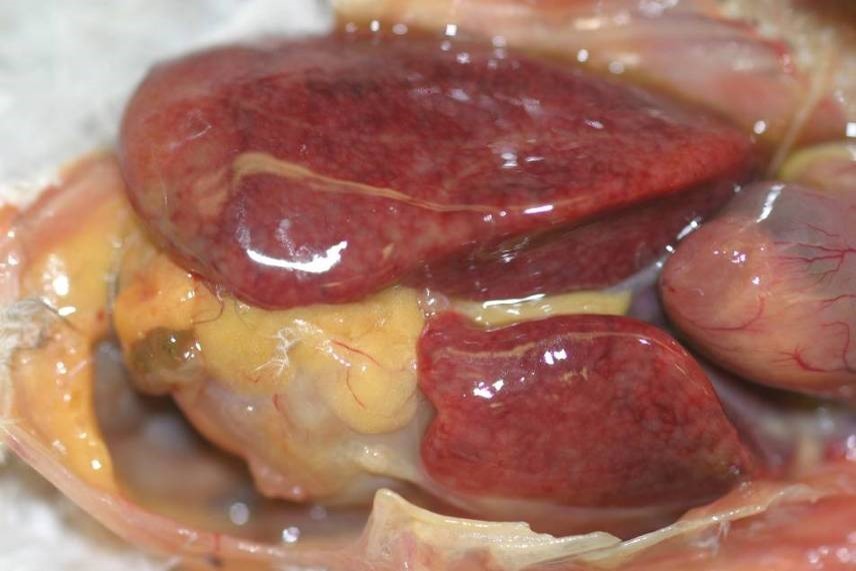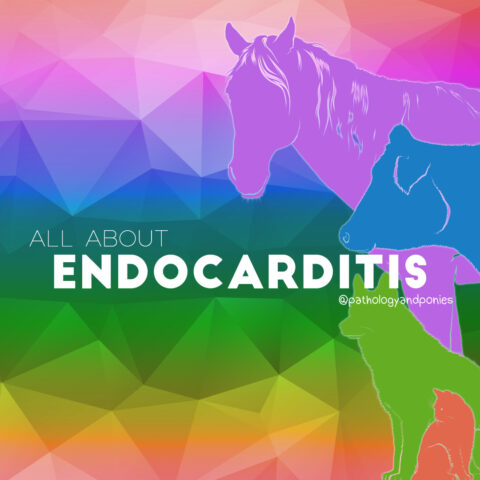Today’s path rounds are on 𝐩𝐬𝐢𝐭𝐭𝐚𝐜𝐨𝐬𝐢𝐬!
𝐖𝐡𝐚𝐭 𝐢𝐬 𝐢𝐭?
𝐏𝐬𝐢𝐭𝐭𝐚𝐜𝐨𝐬𝐢𝐬 is a bacterial infection caused by 𝐂𝐡𝐥𝐚𝐦𝐲𝐝𝐢𝐚 𝐩𝐬𝐢𝐭𝐭𝐚𝐜𝐢. “Psittaci” means parrot, which gives you a clue about what species this disease affects!
𝐖𝐡𝐨 𝐠𝐞𝐭𝐬 𝐢𝐭?
We see this condition primarily in parrots, however it has been identified in over 450 bird species. It is also a 𝐳𝐨𝐨𝐧𝐨𝐭𝐢𝐜 𝐝𝐢𝐬𝐞𝐚𝐬𝐞 (can spread to humans). In people, this disease is called 𝐩𝐚𝐫𝐫𝐨𝐭 𝐟𝐞𝐯𝐞𝐫.
𝐖𝐡𝐚𝐭 𝐜𝐚𝐮𝐬𝐞𝐬 𝐢𝐭?
Chlamydia is shed in the nasal discharge and feces of infected animals, which contaminates the environment with the 𝐞𝐥𝐞𝐦𝐞𝐧𝐭𝐚𝐫𝐲 𝐟𝐨𝐫𝐦 of the bacteria. This form easily survives in the environment, and can stay infectious for several months. Animals will inhale or ingest this form of the bacteria, and the elementary bodies will attach to lining of the respiratory tract or intestine. The elementary body is then eaten by 𝐦𝐚𝐜𝐫𝐨𝐩𝐡𝐚𝐠𝐞𝐬, the body’s major clean up cell, and transforms into a 𝐫𝐞𝐭𝐢𝐜𝐮𝐥𝐚𝐭𝐞 𝐛𝐨𝐝𝐲 that is capable of making new elementary bodies. Once enough elementary bodies are made, the macrophage is split open to release more bacteria into the bloodstream or body secretions.
𝐖𝐡𝐲 𝐢𝐬 𝐭𝐡𝐢𝐬 𝐚 𝐩𝐫𝐨𝐛𝐥𝐞𝐦?
Psittacosis makes the birds quite sick, with fever, weakness, weight loss and nasal discharge. These birds will develop 𝐚𝐢𝐫 𝐬𝐚𝐜𝐜𝐮𝐥𝐢𝐭𝐢𝐬 (bacterial infection of their air sacs), pneumonia and 𝐡𝐞𝐩𝐚𝐭𝐢𝐜 𝐧𝐞𝐜𝐫𝐨𝐬𝐢𝐬 (death of liver cells). In some cases, the infection can be severe enough to cause death in these birds.
𝐇𝐨𝐰 𝐢𝐬 𝐢𝐭 𝐝𝐢𝐚𝐠𝐧𝐨𝐬𝐞𝐝?
Diagnosis is usually made through identifying the bacteria via 𝐏𝐂𝐑, which identifies the bacteria’s DNA directly. Usually, this test is conducted on a swab of the 𝐜𝐡𝐨𝐚𝐧𝐚, essentially the larynx of a bird. Necropsy findings may also be helpful in acutely sick animals.
𝐇𝐨𝐰 𝐢𝐬 𝐢𝐭 𝐭𝐫𝐞𝐚𝐭𝐞𝐝?
Whether or not treatment is allowed for these birds depends on local government regulations, as psittacosis is considered to be a 𝐫𝐞𝐩𝐨𝐫𝐭𝐚𝐛𝐥𝐞 𝐝𝐢𝐬𝐞𝐚𝐬𝐞. This means there are strict procedures that must be followed if the disease is identified, which may include depopulating all affected birds. If treatment is permitted, 𝐭𝐞𝐭𝐫𝐚𝐜𝐲𝐜𝐥𝐢𝐧𝐞 antibiotics can be effective if given over a very long period of time.






𝐏𝐡𝐨𝐭𝐨𝐬
1) A parrot with green feces, a characteristic sign of psittacosis.
2) An example of air sacculitis at the top of the image. Normally the air sac linings are clear, not white!
3-5) Enlarged livers from psittacosis.
6) Purple dit-dot Chlamydia within a macrophage of a parrot (middle of image). Fun fact: red blood cells in parrots have 𝐧𝐮𝐜𝐥𝐞𝐢 (rod-shaped blue things)!
𝐒𝐨𝐮𝐫𝐜𝐞𝐬
Van Wettere AJ. Avian chlamydiosis. Merck Veterinary Manual 2020.
Photos 1-6 © Noah’s Arkive contributors McGavin, Lowenstine, Maddux, Harrington, Uzal licensed under CC BY-SA 4.0.




